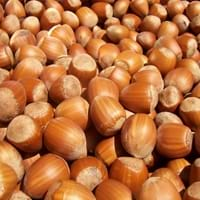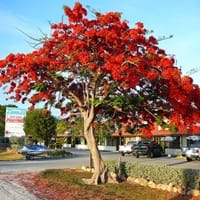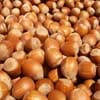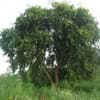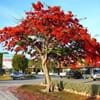Life Span
Perennial
Perennial
Origin
Europe, Northern Africa, Western Asia
Madagascar
Types
Not Available
Delonix regia var. flavida Stehle
Delonix regia var. genuina Stehle
Delonix regia var. genuina Stehlé
Number of Varieties
Not Available
Habitat
Lower slopes, Moist woods, Slopes
gardens, Roadsides, Shaded sites, Woodlands
USDA Hardiness Zone
4-8
10-15
Sunset Zone
2a, 2b, 3a, 3b, 4, 5, 6, 7, 8, 9, 14, 15, 16, 17, 18, 19, 20
H1, H2
Habit
Oval or Rounded
Spreading
Flower Color
Yellow
Red, Orange Red
Flower Color Modifier
Bicolor
Bicolor
Leaf Color in Spring
Green
Green
Leaf Color in Summer
Green, Dark Green
Green, Dark Green
Leaf Color in Fall
Yellow, Green, Brown
Dark Green
Leaf Color in Winter
Not Available
Not Available
Leaf Shape
Cordate
Pinnate
Plant Season
Spring, Summer, Fall
Spring, Summer, Fall
Sunlight
Full Sun, Partial Sun
Full Sun
Type of Soil
Clay, Loam, Sand
Loam, Sand
The pH of Soil
Neutral, Alkaline
Acidic, Neutral, Alkaline
Soil Drainage
Average
Well drained
Bloom Time
Early Spring, Spring, Late Winter
Late Spring, Early Summer, Summer
Tolerances
Not Available
Pollution, Drought, Salt
Where to Plant?
Ground
Ground
How to Plant?
Budding, Seedlings
Grafting, Seedlings, Stem Planting, Transplanting
Plant Maintenance
Medium
Medium
Watering Requirements
Do not water frequently, Needs less watering
Average Water Needs, Reduce watering in winter
In Summer
Lots of watering
Lots of watering
In Spring
Moderate
Moderate
In Winter
Average Water
Average Water
Soil pH
Neutral, Alkaline
Acidic, Neutral, Alkaline
Soil Type
Clay, Loam, Sand
Loam, Sand
Soil Drainage Capacity
Average
Well drained
Sun Exposure
Full Sun, Partial Sun
Full Sun
Pruning
Remove damaged leaves, Remove dead branches, Remove dead leaves
Prune if you want to improve plant shape, Remove damaged leaves, Remove dead branches, Remove dead leaves, Shape and thin as needed
Fertilizers
All-Purpose Liquid Fertilizer
All-Purpose Liquid Fertilizer
Pests and Diseases
Red blotch
Pests and diseases free
Plant Tolerance
Drought
Drought
Flower Petal Number
Not Available
Single
Foliage Texture
Coarse
Fine
Foliage Sheen
Matte
Matte
Attracts
Not Available
Birds, Hummingbirds, Butterflies
Allergy
Not Available
no allergic reactions
Aesthetic Uses
Not Used For Aesthetic Purpose
Beautification, Showy Purposes
Beauty Benefits
Not Available
Not Available
Environmental Uses
Air purification
Air purification
Medicinal Uses
antihelmintic, Astringent, Diaphoretic, Febrifuge, Nutrients, Nutritive
No Medicinal Use
Part of Plant Used
Seeds
Bark, Pods, Sap
Other Uses
Basketary, Cosmetics, used for making charcoal
Gum, Used as firewood, Used As Food, Used as Ornamental plant
Used As Indoor Plant
No
No
Used As Outdoor Plant
Yes
Yes
Garden Design
Edible, Foundation, Fruit / Fruit Tree, Hedges, Mixed Border, Screening / Wind Break
Feature Plant, Shade Trees, Street Trees, Tropical
Botanical Name
CORYLUS avellana 'Rote Zellernuss'
DELONIX regia
Common Name
Common Filbert, Redleaf Filbert
Flamboyant Tree, Flame Tree, Royal Poinciana
In German
Haselnuss
Flamboyant
In French
aveline
Flamboyant
In Spanish
avellana
Extravagante
In Greek
φουντούκι
Επιδεικτικός
In Portuguese
avelã
extravagante
In Polish
leszczyna
Kwiecisty
In Latin
Filbert
flamboyant
Phylum
Tracheophyta
Not Available
Class
Magnoliopsida
Magnoliopsida
Family
Betulaceae
Fabaceae
Clade
Angiosperms, Eudicots, Rosids
Angiosperms, Eudicots, Rosids
Tribe
Not Available
Caesalpinieae
Subfamily
Not Available
Caesalpinioideae
Number of Species
Not Available
Not Available
Season and Care of Filbert and Flamboyant Tree
Season and care of Filbert and Flamboyant Tree is important to know. While considering everything about Filbert and Flamboyant Tree Care, growing season is an essential factor. Filbert season is Spring, Summer and Fall and Flamboyant Tree season is Spring, Summer and Fall. The type of soil for Filbert is Clay, Loam, Sand and for Flamboyant Tree is Loam, Sand while the PH of soil for Filbert is Neutral, Alkaline and for Flamboyant Tree is Acidic, Neutral, Alkaline.
Filbert and Flamboyant Tree Physical Information
Filbert and Flamboyant Tree physical information is very important for comparison. Filbert height is 370.00 cm and width 300.00 cm whereas Flamboyant Tree height is 610.00 cm and width 610.00 cm. The color specification of Filbert and Flamboyant Tree are as follows:
Filbert flower color: Yellow
Filbert leaf color: Green
Flamboyant Tree flower color: Red and Orange Red
- Flamboyant Tree leaf color: Green
Care of Filbert and Flamboyant Tree
Care of Filbert and Flamboyant Tree include pruning, fertilizers, watering etc. Filbert pruning is done Remove damaged leaves, Remove dead branches and Remove dead leaves and Flamboyant Tree pruning is done Prune if you want to improve plant shape, Remove damaged leaves, Remove dead branches, Remove dead leaves and Shape and thin as needed. In summer Filbert needs Lots of watering and in winter, it needs Average Water. Whereas, in summer Flamboyant Tree needs Lots of watering and in winter, it needs Average Water.
